
Photo from wikipedia
The initial step of methanogenesis is the fixation of CO2 to formyl-methanofuran (formyl-MFR) catalyzed by formyl-MFR dehydrogenase, which can be divided into two half reactions. Herein, the second half reaction… Click to show full abstract
The initial step of methanogenesis is the fixation of CO2 to formyl-methanofuran (formyl-MFR) catalyzed by formyl-MFR dehydrogenase, which can be divided into two half reactions. Herein, the second half reaction catalyzed by FwdA (formyl-methanofuran dehydrogenase subunit A), i.e., from formate to formyl-methanofuran, has been investigated using density functional theory and a chemical model based on the X-ray crystal structure. The calculations indicate that, compared with other well-known di-zinc hydrolases, the FwdA reaction employs a reverse mechanism, including the nucleophilic attack of MFR amine on formate carbon leading to a tetrahedral gem-diolate intermediate, two steps of proton transfer from amine to formate moieties assisted by the Asp385, and the CO bond dissociation to form the formyl-MFR product. The second step of proton transfer from the amine moiety to the Asp385 is rate-limiting with an overall barrier of 21.2 kcal/mol. The two zinc ions play an important role in stabilizing the transition states and intermediates, in particular the negative charge at the formate moiety originated from the nucleophilic attack of the MFR amine. The work here appends a crucial piece in the methanogenic mechanistics and advances the understanding of the global carbon cycle.
Journal Title: Journal of inorganic biochemistry
Year Published: 2018
Link to full text (if available)
Share on Social Media: Sign Up to like & get
recommendations!